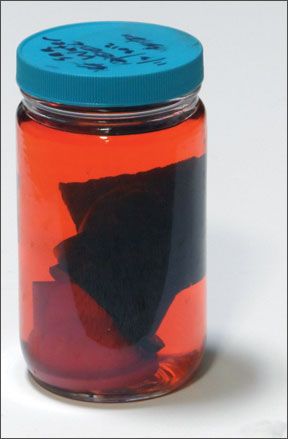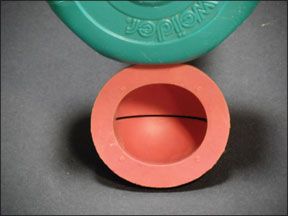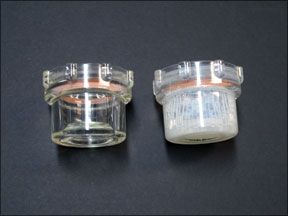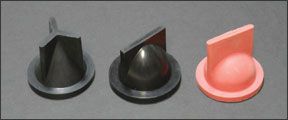We like to joke about our uncooperative marine head. As it turns out, the joke is on us. A comprehensive series of tests recently undertaken by Practical Sailor contributor Drew Frye indicates that we are the ones who are ruining our toilets-ruining them with half-baked home remedies and dubious maintenance regimens passed down through generations of sailors who should have learned by now. All these years that we thought we were coddling our Lil Skipper, we were actually shortening its life.
At the heart of the marine toilet lies the lowly joker valve, the oft-abused gateway through which all waste must pass on its way into the holding tank. Interestingly, the joker valves for Groco, Jabsco, and Raritan manual heads are so nearly identical in dimension and shape as to be interchangeable. If one is best, then shouldnt we all convert to that one that lasts longest? We decided to get to the bottom of this by testing each valve against various chemicals and other substances that are often introduced into the head. The results not only revealed a preferred valve, but also gave us a clear picture of what various concoctions can do to our marine plumbing.
What We Tested
We tested valves from Groco, Jabsco, and Raritan, the three biggest players in the marine toilet business. The valves are made of different materials, so different chemical compatibilities can be expected. Designs differ, too. The Raritan and Groco valves are straight duckbill valves, while the Jabsco is a tricuspid valve that opens slightly wider.
The construction materials also vary in hardness: The Groco and Raritan valves are nitrile, while the Jabsco valve is neoprene. Nitrile is known for exceptional oil and grease resistance, as well as resistance to many solvents and alcohols. Neoprene is oil resistant, but it would not generally be specified where continuous oil or solvent exposure was expected. Neoprene is more flexible, has a superior flex life, holds shape better, and better resists alkalis and ammonia. Either material should do fine in a head that is exposed to sewage and only a few drops of oil now and then. Since Groco and Raritan use neoprene components in other areas of the pump, excessive use of solvents can ruin all of these systems.
What about acids? Both nitrile and neoprene can withstand occasional exposure to weak acids (vinegar or CLR, a mild acid cleaner sold at most hardware stores to combat lime buildup) or the diluted acids (5-percent muriatic acid) that boaters typically use to remove lime and rust stains.
Disinfectants? Many contain benzyl compounds, which are very tough on both neoprene and nitrile. Avoid using these in your marine head, or expect rapid system failure.
When it comes to withstanding winterizing agents, nitrile comes out on top. Nitrile is rated for propylene glycol, and neoprene is not. Both materials are rated for ethylene glycol, so if neoprene is the material of choice, it seems clear that we should winterize waste systems with ethylene glycol.

All of the toilet manufacturer manuals suggest annually applying synthetic grease such as Super Lube Synthetic to the pump. Some sailors suggest flushing vegetable oil as a regular practice, but there are several problems with that regimen. First, vegetable oils are actually quite variable in their compatibilities: corn oil is significantly aggressive toward neoprene, while olive oil, soy oil, grapeseed oil, and canola oil are more benign. Baby oil and mineral oil are sometimes recommended by sailors as well.
Another concern is that excessive use of vegetable or mineral oil can lead to clogging and odors. Vegetable oil makes waste and hose walls sticky. Mineral oil can coat the surface of the holding tank, preventing the transfer of oxygen and leading to a build-up of odiferous hydrogen sulfide.
We tested this theory in the Practical Sailor test holding tanks and found that using oil only caused a minor increase in odors. We now question this practice. Its better to open the pump every season or two, and grease the piston generously, as manufacturers recommend.
When it comes to cleaning agents, Practical Sailors past research has shown that cleaning practices and chemicals that augment aerobic bioactivity are the best way to reduce head and holding tank odors; sterilizing chemicals did not work. Some cleaners also will help deodorize the bowl and are safe for the head. Regular use of these products and a long-handle scrub brush can work miracles with head odors (PS, December 2012).
Some sterilizing cleaners such as Vanish toilet cleaner and some Clorox products contain benzyl compounds, which, as mentioned, are very tough on neoprene and nitrile. Cleaners containing bleach are also rough on both materials, but not so damaging. However, bleach cleaners can kill a healthy holding tank culture and increase pump-out difficulties. If you want an odor-free holding tank, you should avoid all sterilizing chemicals.
The only other cleaners approved for weekly to monthly use are white vinegar or CLR, both used for combatting lime build-up. Preventing lime build-up is particularly important for saltwater-flushed heads. Sufficient flushing also reduces scale build-up.

Perhaps the best head maintenance suggestion is to flush sufficiently to move the waste out of the bowl, up the hose, and past the high point of the hose (usually a vented loop) so that it flows into the holding tank and not back toward the bowl. This will also make pump-outs easier, as the waste is more diluted and less likely to permeate the hoses. With positive flushing, any back-flow past the joker valve-eventually, there will be some-will be clear water.
How much manual-head pumping is required to clear the hose? About two strokes for every foot of discharge hose. The Groco HF, Jabsco Twist-N-Lock, and Raritan PHII toilets all move about six ounces per stroke. If youre concerned about filling the holding tank too quickly with clean flushing water, one option is to only clear the hose at the end of the day, or before leaving the boat.
How We Tested
Our chemical exposure testing involved soaking each joker valve in a variety of chemicals likely to be used in a marine head. We exposed the three different joker valves simultaneously in the same jars, one chemical at a time. We had several of each valve, minimizing the exposure to multiple chemicals. The duration of exposure varied according to how the chemical would be used. For example, the valves were exposed longer to glycols found in antifreeze blends than to cleaners. In every case, we tried to find a concentration that was realistic. The temperature was fixed at 70 degrees. In the case of cooking oil, we used a small amount and then shook the jars weekly to insure a continuous thin coating.
Before and after exposure, we measured the following:
Dimensional stability: Either growth or shrinkage in the valve is a sign that the chemical is absorbing into the rubber, leaching something out. Either can lead to weakening or cracking of product. Additionally, shrinkage or swelling can cause a duckbill valve to stay open, since the flange portion of the valve is fixed.

Stiffness: We placed a weight on the flange edge-wise and measured the deflection. Any change suggests that the rubber is being degraded. Leakage: We filled a 30-inch stand pipe with water and measured leakage. This created back pressure equivalent to the rise from the joker valve to the holding tank inlet.
Object passage: Wetted plastic screwdrivers were used to measure opening. No significant changes were observed, in spite of some stiffening.
On-boat comparison: We installed each valve on a live-aboard boat with twin Jabsco Twist-and-Lock heads and tested them side-by-side for six months. They all fit without trouble, and differences in flushing and sealing were noted.
Side note-Nylon strainers: We also tested the nylon strainers from Shurflo that are found in many potable water systems. One pair was exposed to glycols in the laboratory, and one pair on a test boat. The result was troubling: The strainer exposed to propylene glycol was severely crazed and ruined, and the strainer exposed to ethylene glycol was also slightly crazed. The cracks caused by ethylene glycol were not visible for several days and were nearly overlooked; only after soaking the strainers in water and allowing them to dry for several days did the cracks appear. Be sure to wash and dry your bowls before inspecting. To avoid trouble altogether, remove nylon bowls when glycol is added.
Joker Valve Findings
While we anticipated some notable differences between the joker valves, many of our findings were unexpected.
Groco
Grocos black nitrile duckbill valve demonstrated Excellent chemical resistance and back-flow resistance. It was the stiffest of the group, and our on-boat testers observed greater pumping resistance with this valve than with the Jabsco valve. It should prove durable, and it fits Groco, Jabsco, and Raritan manual heads.
Bottom line: At $7, the Groco duckbill valve is our Budget Buy.
Jabsco
Testers noted that this black-neoprene tricuspid valve stands apart from the competition in several ways. Because of its unique three-corner design and softer compound, it opens wider (presenting 60-percent greater area than Raritan and Groco). It creates less pumping resistance and greater clog resistance than any other valve.
The primary negative is that neoprene is not as resistant to propylene glycol, a common winterizing agent. You can partly reverse any damage by soaking the valve in fresh or sea water for several weeks. While Jabsco acknowledges that ethylene glycol is the best winterization product for its head, they do not suggest ethylene glycol because of liability concerns regarding mammalian toxicity. Resistance to petroleum oil is somewhat less, but resistance to olive oil and waterproof greases is excellent.
Bottom line: If you are careful about your winterizing procedure, you should have no problems with this valve. Because of its superior functionality, this valve is our Best Choice. It fits Raritan and Groco heads, as well as Jabsco heads.
Raritan
This red-nitrile duckbill valve demonstrated Excellent chemical resistance. While it wasnt as stiff as the Groco valve, it did create some resistance in the flush cycle. The Raritan valve is generally considered to be the most durable, but in our testing, it didnt resist stale urine as well as other valves. It became stiff, lost resilience, and leaked (in the lab and on the test boat).
Bottom line: The Raritan valve fits Groco, Jabsco, and Raritan manual heads. It was the most expensive valve and did not seem to add significant value. Recommended.
Chemical Resistance
In addition to our comments on each joker valve, we made some interesting observations on the chemicals that are often introduced to marine heads.
Ethylene glycol: As a result of our experiments, we recommend using ethylene glycol instead of propylene glycol anywhere human toxicity is not a concern. Black-water systems are fine, but avoid introducing ethylene glycol to the environment.

Propylene glycol: Propylene glycol dramatically stiffens neoprene, although you can soften the effected neoprene some by soaking it in water. Propylene glycol is not good for Jabsco joker valves and is bad for flexible neoprene impellers, particularly engine raw-water impellers. Several experienced mechanics we spoke with were convinced that winter storage in propylene glycol ruins impellers. Ethylene glycol is a better choice for engines and black-water systems, and draining may be a better approach to winterizing potable water systems. The propylene glycol severely crazed nylon strainers in our tests.
Methanol Windshield De-icer: De-icers did not cause any damage to our sample joker valves, but we don’t recommend them because of the risk they pose to other materials in the system.
Oils: While olive oil proved harmless to all test valves, corn oil caused some minor swelling, and baby oil caused the Jabsco valves to swell and soften. The Groco and Raritan nitrile valves were unaffected.
Urine: Urine was the most damaging off all the chemicals tested, inducing minor leaks in the Raritan valve. The fix is obvious: Flush the waste clear to the tank.
Acids: We soaked the valves in diluted CLR, Lime-Away (sulfamic acid cleaner), vinegar, and 3-percent hydrochloric acid (diluted to 1 percent HCl) for a month. Vinegar caused minor and apparently harmless swelling in the neoprene valve, but not the nitrile valves. CLR caused significantly less swelling than vinegar and removed the lime several times faster, with less residue. Lime-Away damaged the nitrile valve, so don’t use this product in marine heads. Hydrochloric acid works fast and did not damage the rubber, but it is nasty to work with and its difficult to judge the dosage. Acid cleaning did not restore resiliency lost in the Raritan valve due to urine exposure. We recommend only CLR for acid cleaning.
Head treatments: We tried several of the most aggressive old-school blue treatments (Aqua-Kem and West Marine Max Control) and noted no important effects, although the alkalinity caused some minor stiffening of nitrile. We see no problem with using these, if the treatment is flushed through as directed.
Ammonia: Ammonia caused similar stiffening and loss in material resiliency that we saw with urine, but without the scale formation. We also can’t think of any good reason to use it.
Bleach: Bleach did no harm to components, but we do not recommend using it. It is bad for the holding tank bio-organisms and is incompatible with many holding-tank treatments.
Lysol Toilet Cleaner: We saw slight swelling in the valves after they were exposed to the Lysol cleaner, but nothing serious. Not recommended.
Grease: We tested valve compatibility with trailer bearing grease, Super Lube Synthetic grease, and Ideal Silicone Dielectric grease. The wheel bearing grease caused some minor swelling in the Jabsco valve. The other products had no effect.
Conclusion
For winterizing waste systems, we recommend either draining the system according to manufacturer instructions or using ethylene glycol instead of propylene glycol. Lubricate annually with synthetic grease, and if you must flush oil, use olive oil.
Flush well. The most damaging substance tested was stale urine, so moving the waste through the hose and into the tank is your best protection against scale, joker valve failure, and hose permeation.
If you must use cleaning products, we recommend marine and RV products marketed for this purpose; read the toilets owners manual and avoid most everything sold in the grocery store for that purpose. CLR is the best mild acid cleaner for scaling control. Never use Lysol or any cleaner containing solvent, benzyl compounds, or natural oils-these can lead to a quick failure-and do not use bleach or disinfecting cleaners, as these conflict with good aerobic holding tank maintenance practices.
What about winterizing potable water systems? Although propylene glycol can harm neoprene, we have little choice; only propylene glycol is acceptable. A simple system, however, can be drained and blown out with air. Remove all nylon strainer bowls; propylene glycol can ruin them in a single winter. While neoprene potable-water impellers can survive this propylene glycol abuse, engine raw-water impellers are a different matter; winterize neoprene engine impellers with ethylene glycol.
Dont use a plumbers plunger in the bowl. Flapper and joker valves can be inverted and damaged by a good firm pull. If there is one on the boat, take it home before a guest uses it.
Install the joker valve with the slot vertical; if installed horizontally, the slot will droop and start leaking sooner. Do not over tighten flange bolts since this can cause distortion and backflow. Discharge rise should be kept to less than 4 feet, and the line should slope toward the holding tank; this will minimize back-flow and hose permeation.
So which is the best joker valve? If the valve is replaced every one to two years, as recommended, and inappropriate chemical exposures are avoided, all of these should last the required interval and perform well. We believe the differences observed in the field have more to do with flushing and cleaning practices than the valve material or design.
Based upon comments from sailors, we expected the Raritan to perform best, but the Jabsco valve demonstrated clear superiority in resistance to urine, flexibility, and flushing resistance. What if the chandlery has only one brand on the shelf? Any of them will work, but well be using Jabsco valves and watching what we flush.
VALUE GUIDE: Joker Valves
| BRAND | GROCO | JABSCO / XYLEM FLOW | RARITAN |
|---|---|---|---|
| FITS MODEL | HF and K | Twist-N-Lock 29090, 29120, 58500 | PH-II, PHE-II, PHC Crown Head, Crown Head II |
| FEATURES | Duckbill valve | Tricuspid valve | Duckbill valve |
| MATERIAL | Nitrile | Neoprene | Nitrile |
| COLOR | Black | Black | Red |
| DIAMETER | 2.375 in. | 2.313 in. | 2.250 in. |
| HEIGHT | 1.75 in. | 1.94 in. | 1.94 in. |
| OPENING SIZE | 0.8 sq. in. | 1.3 sq. in. | 0.8 sq. in. |
| COST | $7 | $10 | $19 |






































8BET is the particular greatest online gambling site in Asian countries.
188BET is also an online gambling site that
provides a myriad of achievements in the on the internet betting field.
188BET is additionally the the majority of comprehensive betting site that provides different attractive promotions for all bettors in Parts of asia.
The 188BET site has also recently been established since 2006 to serve all betting fans within Asia
to date.